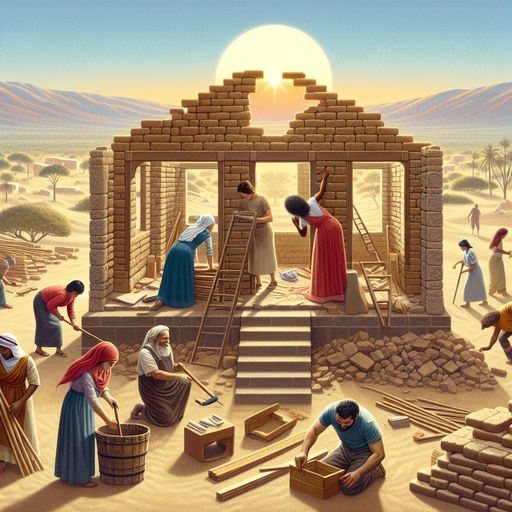In this article, we explore Amos 9:11, a profound verse that reveals God’s promise of restoration and hope. Discover the historical context and spiritual significance of this passage, as we delve into its implications for faith and community in today’s world. 
Exploring Amos 9:11: A Deep Dive into Its Meaning and Significance
Have you ever stumbled upon a verse in the Bible that made you pause and think, “What does that really mean?” If you’re curious about Amos 9:11, you’re not alone! This verse holds deep meaning and resonates throughout the ages. In this article, we will explore the context, interpretation, and relevance of Amos 9:11, ensuring you walk away with a clear understanding.Understanding the Verse: What Does Amos 9:11 Say?
The book of Amos is one of the Minor Prophets in the Old Testament. Amos 9:11 states, “In that day I will restore David’s fallen shelter—I will repair its broken walls and restore its ruins—and will rebuild it as it used to be.” This verse is a promise of restoration and renewal. It signifies hope amidst despair, highlighting the belief that God can mend what is broken. But why is this verse so important?The Historical Context of Amos
To grasp the full significance of Amos 9:11, we must first understand the context in which it was written. Amos was a shepherd and a fig tree farmer from Judah, who prophesied during a time of great social injustice in Israel (around 760-750 B.C.). His messages often focused on God’s judgment against the unfaithfulness of Israel and their failure to uphold righteousness. The nation faced impending doom due to their actions. However, broadcasts of God’s judgment are often followed by a message of hope, which leads us directly to Amos 9:11.Why Restoration Is Key
The imagery of restoring David’s fallen shelter carries profound implications. The “shelter” symbolizes God’s covenant relationship with His people. By promising to restore it, Amos conveys that God has not forgotten His people, even in times of trouble. When considering the **restoration** mentioned in Amos 9:11, it serves as a reminder that no matter how far one strays or how broken their situation appears, there is always a path back to wholeness.Interpretations of Amos 9:11
Amos 9:11 has been viewed through various lenses. Here are a few key interpretations:1. A Message of Hope
For many believers, this verse represents divine assurance. It emphasizes that God is a God of second chances. The promise reveals that He desires to bring back the lost and restore relationships. This message of hope can be particularly comforting in challenging times.2. Spiritual Restoration
Beyond physical restoration, Amos 9:11 also speaks to spiritual rejuvenation. Just as walls can be rebuilt, so can faith be renewed. True restoration often begins internally, inviting individuals to reconnect with their spiritual roots.3. Future Prophecy
Some theologians interpret this verse as a foretelling of Christ’s coming. They view the restoration as a reference to the new covenant established through Jesus, which brings salvation and redemption to all. This perspective not only enhances the importance of the verse but also links the Old Testament with the New Testament, showcasing God’s ongoing plan for humanity.Modern Relevance of Amos 9:11
So why should Amos 9:11 matter today? In our fast-paced world, many feel overwhelmed by chaos and uncertainty. The themes of **restoration** and **renewal** resonate deeply with those facing challenges—be they personal struggles, societal issues, or loss of hope. Amos’s promise shines as a beacon for individuals searching for comfort. It reassures us that transformation is possible; whether on a personal level or in broader society, change can come.Conclusion: Embracing the Promise of Amos 9:11
In closing, Amos 9:11 stands as a significant declaration of restoration from God. It reflects His unwavering commitment to His people, urging us to remember that brokenness can be repaired and faith can be rekindled. As you study this verse, allow it to inspire hope within you. Whether you’re wrestling with personal doubts or seeking clarity in chaotic times, take solace in knowing that, just as God promised in Amos, renewal awaits those who earnestly seek it. Remember, **the story of restoration is alive**, and each of us plays a part in it. Engage deeply with the message of Amos, and let it guide your journey toward understanding and faith.Questions and answers on “Restoration and Hope: Unpacking the Promise of Amos 9:11”
What is the significance of Amos 9:11 in the context of religion?
Amos 9:11 is significant because it speaks to the restoration of Israel and the future hope for God’s people. The verse proclaims that God will raise up the fallen tent of David, symbolizing the **restoration of the Davidic kingdom**. This reflects a theme of redemption and divine promise in religious belief.
2. How do different religious traditions interpret Amos 9:11?
Different religious traditions may interpret Amos 9:11 uniquely. For Christians, it is often viewed as a prophecy about Jesus Christ and His role in restoring the Kingdom of God. In Judaism, it emphasizes God’s faithfulness to His covenant with the Israelites and the eventual return of the exiled people. **Understanding these interpretations can deepen one’s faith**.
3. What does Amos 9:11 reveal about God’s nature in religious texts?
Amos 9:11 reveals that God is a **God of restoration and hope**. This verse illustrates God’s willingness to restore what has been broken and to fulfill His promises. It showcases His commitment to His people, highlighting **the relationship between divine justice and mercy** in religious texts.
Further reflections on Amos 9:11
Key Concepts in Christian Theology: The Significance of Amos 9:11
In the realm of Christian theology, various scriptures serve as foundational texts that shape the beliefs and practices of believers. One such scripture is Amos 9:11, a verse rich in meaning and offering profound insights into the nature of God’s promises and restoration. This article will delve into the nuances of Amos 9:11 KJV, Amos 9:11 NKJV, and other translations, while exploring the implications of this passage on modern religious teachings and the lives of believers.
Understanding Amos 9:11
The verse states: “In that day will I raise up the tabernacle of David that is fallen, and close up the breaches thereof; and I will raise up his ruins, and I will build it as in the days of old.” – Amos 9:11 KJV This scripture speaks to the promise of restoration and the rebuilding of the ‘tabernacle of David.’ To fully grasp its significance, we must explore its context and meaning.
The Tabernacle of David
The phrase tabernacle of David refers to the sanctuary and worship space established under King David, symbolizing unity, divine presence, and worship. In theological terms, this restoration is not merely physical but also spiritual. It represents the reestablishment of God’s relationship with His people, as noted in the commentary on Amos 9:11. The term draws attention to God’s desire for fellowship and communion with humanity. As believers reflect on this, they are reminded of the hope that God provides through His covenant relationships throughout history.
Modern Religious Teachings
In contemporary Christianity, the themes extrapolated from Amos 9:11 NKJV resonate deeply within various denominations. Sermons often reference this passage to underscore God’s commitment to restoring broken lives and communities. Many churches utilize this scripture to encourage communal worship and reconciliation, emphasizing the importance of collective faith. For instance, when community outreach initiatives are launched within congregations, they are often seen as a manifestation of the rebuilding promised in Amos 9:11 12. Believers see their participation in these acts as part of fulfilling the divine restoration that God has ordained.
Meaning and Impact on Daily Life
The meaning behind Amos 9:11 extends to the individual believer’s life as well. Many Christians interpret this promise as an invitation to personal renewal. By engaging in prayer, worship, and acts of service, individuals seek to experience their own “tabernacle” of spiritual revitalization. Moreover, the notion of restoration discussed in Amos 9:11 Message emphasizes that no one is beyond the reach of God’s grace. This is especially relevant for those struggling with personal challenges, as it reinforces the belief that God can repair their brokenness and restore hope.
Examples in Faithful Living
Examples of these biblical principles manifest in several ways: 1. **Community Worship**: Many congregations host revival services inspired by the tabernacle of David concept, focusing on uplifting worship and inviting God’s presence. 2. **Acts of Kindness**: Programs aimed at feeding the poor or helping the needy often draw inspiration from the idea of restoration found in Amos 9:11. 3. **Personal Testimonies**: Believers frequently share testimonies of how they have experienced God’s restoration in their own lives, validating the promises outlined in this scripture. 4. **Intercessory Prayer**: Many faithful engage in prayer not only for personal needs but also for the healing and restoration of their communities, reflecting the broader vision presented in Amos 9:11.
Conclusion
In summary, Amos 9:11 stands as a powerful reminder of God’s unyielding commitment to His people, both in ancient times and today. Its themes of restoration permeate modern religious teachings, encouraging believers to actively participate in the rebuilding of spiritual and community bonds. Through the lens of this scripture, Christians are inspired to embody the love and restoration that God offers, impacting their daily lives and the lives of those around them. As we reflect on the words of Amos, may we embrace the hope and promise contained within this verse, allowing it to guide us toward a deeper relationship with the Creator and a more profound connection with our communities.
